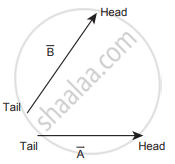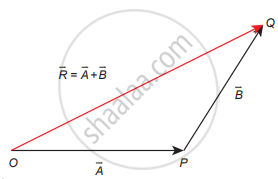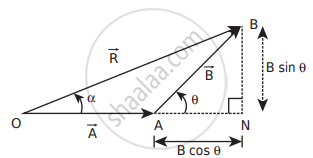Advertisements
Advertisements
Question
Explain in detail the triangle law of addition.
Solution
Let us consider two vectors `vecA` and `vecB` as shown in the figure. To find the resultant of the two vectors we apply the triangular.
Law of addition as follows:
present the vectors A and by the two adjacent sides of a triangle taken in the same order. Then the result is given by the third side of the triangle as shown in the figure.

Head and tail of vectors

Triangle law of addition
To explain further, the head of the first vector `vecA` is connected to the tail of the second vect `vecB` Let O he the angle between `vecA` and `vecB`. Then `vecR` is the resultant vector connecting the tail of the first vector `vecA` to the head of the second vector `vecB` The magnitude of `vecR`. (resultant) given geometrically by the length of (OQ) and the direction of the resultant vector is the angle between `vecR`. and `vecA`. Thus we write
`vecR = vecA + vec(B) vec(OQ) = vec(OP) + vec(PQ)`
1. Magnitude of resultant vector:
The magnitude and angle of the resultant vector are determined by using the triangle law of vectors as follows. From the figure, consider the triangle ABN, which is obtained by extending the side OA to ON. ABN is a right-angled triangle.

Resultant vector and its direction by triangle law of addition
From the figure, let R is the magnitude of the resultant of `vecA` and `vecB`.
cos θ = `"AN"/"B"` ∴ AN = B cos θ and sinθ = `"BN"/"B"` ∴ BN = B sinθ
For ∆ OBN, we have OB2 = ON2 + BN2
⇒ R2 = (A + B cos θ)2 + (B sinθ)2
⇒ R2 = A2 + B2 cos2θ + 2ABcosθ B2 sin2θ
⇒ R2 = A2 + B2(cos2θ + sin2θ) + 2AB cos θ
⇒ R2 = `sqrt(A^2 + B^2 + 2ABcostheta)`
2. Direction of resultant vectors:
If 0 is the angle between `vecA` and `vecB` then,
`|vecA + vecB| = sqrt(A^2 + B^2 + 2ABcostheta)`
If R makes an angle α with `vecA`, then in AOBN,
tan α = `"BN"/"ON" = "BN"/("OA + AN")`
tan α = `(Bsintheta)/(A + Bcostheta) ⇒ α = tan^-1((Bsintheta)/(A + Bcostheta))`
APPEARS IN
RELATED QUESTIONS
Two objects of masses m1 and m2 fall from the heights h1 and h2 respectively. The ratio of the magnitude of their momenta when they hit the ground is ______
Define a vector. Give examples?
Write a short note on the vector product between two vectors.
Discuss the properties of scalar and vector products.
Convert the vector `vecr = 3hati + 2hatj` into a unit vector.
What are the resultants of the vector product of two given vectors given by `vecA = 4hati - 2hatj + hatk` and `vecB = 5hati + 3hatj - 4hatk`?
Calculate the area of the triangle for which two of its sides are given by the vectors `vecA = 5hati - 3hatj, vecB = 4hati + 6hatj`
The resultant of two vectors A and B is perpendicular to vector A and its magnitude is equal to half of the magnitude of vector B. Then the angle between A and B is
